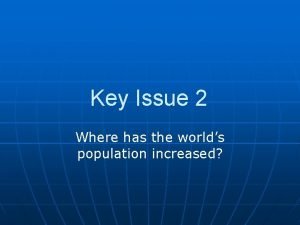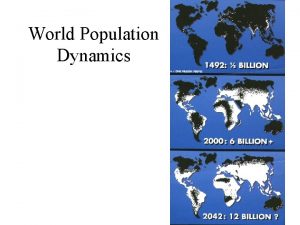Population Explosion and Control Unit 2 CGW 4











- Slides: 11

Population Explosion and Control Unit 2 CGW 4 U 0

Overview of Demographic Transition • In stage one, pre-industrial society, death rates and birth rates are high and roughly in balance. All human populations are believed to have had this balance until the late 18 th century, when this balance ended in Western Europe. • In stage two, that of a developing country, the death rates drop rapidly due to improvements in food supply and sanitation, which increase life spans and reduce disease. The improvements specific to food supply typically include selective breeding and crop rotation and farming techniques.

• In stage three, birth rates fall due to access to contraception, increases in wages, urbanization, a reduction in subsistence agriculture, an increase in the status and education of women, a reduction in the value of children's work, an increase in parental investment in the education of children and other social changes. • During stage four there are both low birth rates and low death rates. Birth rates may drop to well below replacement level as happened in countries like Germany, Italy, and Japan, leading to a shrinking population, a threat to many industries that rely on population growth.

Post-transition • A country’s birth rate equals, or may even fall below, its death rate. As a result, the populations stabilizes or begins to decline. • Countries shift into post-transition as they experience the benefits of economic and social growth. • Ex. urbanization, the changed role of women, rich resource base, and accessibility to education, health care and advanced technology.

Too many people: the demographic trap • Some researchers believe that the nations of the near core and far periphery will never reach post-transition. • they many fall into a demographic trap, where the country experiences high birth rate instead of the declining birth rate of the late transition stage. • a high birth rate and low death rate puts a strain on a country; more food needed, medical, educational services. • issues - ? • food, education, employment

Population Control • China and India have 37% of the world’s population • In 2006, China’s pop’n was approx. 1. 3 billion and India was 1. 1 billion, birth rates have declined. • It is expected between 2020 and 2030 that India will surpass China’s population. • Both countries have reduced their fertility rates through government driven population control measures, but China’s has been more strict.

In this undated poster, China advertises its one-child policy as a means to a "prosperous life. "

English translation: "Up agricultural production, down population increase"

A 1992 poster from the India Ministry of Health and Family Welfare

An undated poster from the National Council for Population and Development

Homework • H. W. read pg. 88 - 92 • Case study on 92 -94 (read)
 Population explosion definition
Population explosion definition Factors affecting population explosion
Factors affecting population explosion Population explosion
Population explosion The population explosion
The population explosion The population explosion
The population explosion Example of population explosion
Example of population explosion Population explosion in india
Population explosion in india Population explosion definition
Population explosion definition Population explosion industrial revolution
Population explosion industrial revolution Cgw middle school
Cgw middle school Maslow's theory maintains that
Maslow's theory maintains that Population ecology section 1 population dynamics answer key
Population ecology section 1 population dynamics answer key
















